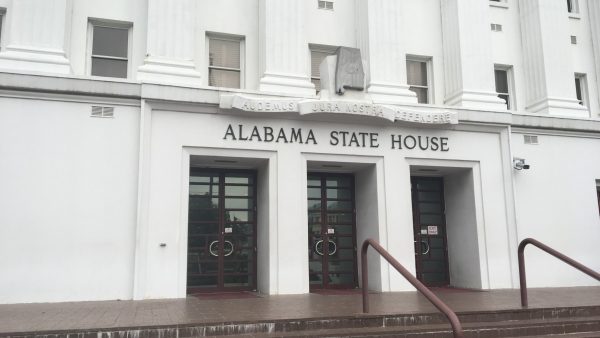Judge Approves Jefferson County’s Plan to Exit Bankruptcy
Federal bankruptcy judge Thomas Bennett has confirmed Jefferson County’s bankruptcy plan, paving the way for the county to exit its $4.2 billion bankruptcy in December. Most of that debt was linked to corruption, mismanagement and bad deals around the county sewer system.
Thursday’s ruling ends two years under municipal bankruptcy, the second largest in U.S. history after Detroit’s filing earlier this year. County leaders say the confirmation allows Jefferson County move past its fiscal turmoil.
The plan calls for creditors to give up about $1.5 billion in concessions. Meanwhile, sewer customers will see their rates rise for 40 years. Businesses already took a 3.49 percent increase on November 1. Then for the next four years business and residential customer rates go up 7.89 percent. Sewer rates rise by 3.49 percent a year after that.
Jefferson County Commission President David Carrington is pleased the court approved the plan. He says the plan’s viability is shown through the fact the county was able to find investors to buy almost $1.8 billion in refinanced debt.
“They didn’t do it on a lark,” said Carrington. “They studied it. They understood it. They asked difficult questions.”
Jefferson County spent almost 26 million dollars in fees to lawyers and other groups through the process, but Carrington says it was worth it. After the county officially exits bankruptcy December 3rd, it can focus on economic development.
“What the county needs is more jobs, more business. That will stimulate a growth in population and it’ll stimulate housing developments and so we’re excited to move into the next phase of this commission,” Carrington said.
The judge turned back challenges from two groups of sewer customers, but they could appeal.
Critics say the plan could set things up for more problems down the line and point out the county’s debt payments rise dramatically after 10 years. Leaving the potential for more rate increases or a return trip to the bankruptcy court.
Andreas Rauterkus, finance professor at UAB, wasn’t surprised the judge approved the plan. But he says that jump in payments is concerning.
“For the county to be able to pay off or make the debt payments 10, 15, 20, 30, 40 years from now…there’s a lot of uncertainty there,” said Rauterkus.
He says it’s unlikely the county will be able to refinance under more favorable terms in 10 years, even with a better credit rating, because interest rates will probably be higher. Rauterkus also says the county may have difficulty attracting new sewer customers through economic development because of higher bills. He points to the future Interstate 22 which could be completed next year.
“A lot businesses in particular are gonna say I can just build in Walker County. I have the exact same connection to the interstate system but I can do it at a much lower cost,” said Rauterkus.
While much of the plan exists in the complex the world of municipal finance, those rate increases are what the general public will see. Dan Jones, owner of University Laundromat in Birmingham, is not happy about that.
Jones estimates says the rate increases that have already gone into effect for business will cost him an extra $600 a year. That eats into already thin profit margins or forces him to raise prices.
“That’s the last thing I want to do,” said Jones.
Jones doesn’t believe residents should have to pay higher rates given that corruption was a contributor to the massive bankruptcy.
“I deal in quarters down here. So you get talking it takes a lot quarters to make a billion dollars, but they’re trying to get it back a quarter at time from us and that’s not right,” Jones said.
The slogan for Jones’ laundromat is “wash, rise, repeat.” Jefferson County has been through the financial wash and rinsed off through bankruptcy. The question now is if in ten years it will repeat.
~ Andrew Yeager, November 22, 2013
Attitudes among Alabama lawmakers softening on Medicaid expansion
Alabama is one of ten states which has not expanded Medicaid. Republican leaders have pushed back against the idea for years.
Birmingham is 3rd worst in the Southeast for ozone pollution, new report says
The American Lung Association's "State of the Air" report shows some metro areas in the Gulf States continue to have poor air quality.
Why haven’t Kansas and Alabama — among other holdouts — expanded access to Medicaid?
Only 10 states have not joined the federal program that expands Medicaid to people who are still in the "coverage gap" for health care
Once praised, settlement to help sickened BP oil spill workers leaves most with nearly nothing
Thousands of ordinary people who helped clean up after the 2010 BP oil spill in the Gulf of Mexico say they got sick. A court settlement was supposed to help compensate them, but it hasn’t turned out as expected.
Q&A: How harm reduction can help mitigate the opioid crisis
Maia Szalavitz discusses harm reduction's effectiveness against drug addiction, how punitive policies can hurt people who need pain medication and more.
The Gulf States Newsroom is hiring a Community Engagement Producer
The Gulf States Newsroom is seeking a curious, creative and collaborative professional to work with our regional team to build up engaged journalism efforts.







